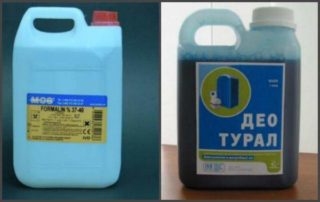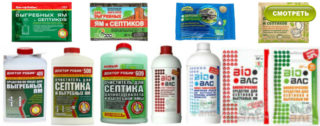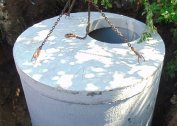On the territory of many suburban areas, cesspools are arranged; they require proper operation. Failure to comply with certain requirements is fraught with rapid filling of pits.
Why is the pit filling up fast
 There may be several reasons for the rapid filling of cesspools. There are two types of such “pits” - with open and closed bottom. In the case of the first variety, drainage into the ground is observed. The second variety is called a septic tank-drive, for its emptying use a sewage machine. Sanitary standards prohibit the use of open cesspools, they pose a great threat to the soil and groundwater. If the owner of the land uses an open pit, he endangers his health. Sewage from sewers can pollute the water, and this will lead to infection of the entire village if water is taken from one pool.
There may be several reasons for the rapid filling of cesspools. There are two types of such “pits” - with open and closed bottom. In the case of the first variety, drainage into the ground is observed. The second variety is called a septic tank-drive, for its emptying use a sewage machine. Sanitary standards prohibit the use of open cesspools, they pose a great threat to the soil and groundwater. If the owner of the land uses an open pit, he endangers his health. Sewage from sewers can pollute the water, and this will lead to infection of the entire village if water is taken from one pool.
Despite the ban, open bottom pits are actively used in rural areas and even in cities. Often temporary pits are equipped at the stage of construction of private houses. During operation, they quickly fill up and the reasons for this are different.
- Not enough volume.
- High groundwater level.
- Accumulation of a large amount of silt or fat deposits on the bottom and walls.
- Freezing soil.
- The abundance of clay in the soil.
When arranging drain pits, it is not always possible to correctly calculate their volume. If for some reason the amount of wastewater increases, the septic tank can overflow. This often happens during snowmelt in the spring, during heavy rains, and over-saturation of the soil with moisture. With prolonged and heavy rainfall, pits overflow even in the absence of sewage from sewers.
Silted one and the walls become the reason for the formation of a dense crust on them, which prevents moisture from entering the soil.
Overfilling of the pits occurs with excessive accumulation of body fat. The water-repellent membrane prevents the absorption of moisture by the walls and bottom.
Freezing of the soil leads to freezing of wastewater, the formation of an ice crust on the surface.
Unsuitable soil with a high concentration of clay does not allow water to go into the ground and the waste tank overflows.
Methods for solving the problem
If the pit is filled to the limit and drains begin to flow out of it, spilling over the site, polluting the soil and spreading stench, ecological disaster can be eliminated using one of the following methods.
The call of the cesspool truck
 The most popular option is to call a cesspool machine. During the pumping process, the maximum possible amount of silty deposits accumulated on the bottom and walls is removed. Fat deposits are washed off by a stream of water supplied under pressure from a hose. With a dense structure of bottom sediments, a metal pipe or a long pole is used. The mass settled to the bottom softens and is easily pumped out using a pump.
The most popular option is to call a cesspool machine. During the pumping process, the maximum possible amount of silty deposits accumulated on the bottom and walls is removed. Fat deposits are washed off by a stream of water supplied under pressure from a hose. With a dense structure of bottom sediments, a metal pipe or a long pole is used. The mass settled to the bottom softens and is easily pumped out using a pump.
If possible, after draining the effluent, you can again fill the pit with clean water and re-pump.
Mechanical cleaning with folk remedies
Cleaning is also performed manually. Folk remedies are used after emptying the pit with a cesspool machine. This approach makes it possible for a long time to get rid of deposits that were deeply led into the bottom with walls. To do this, go down into the pit and remove soil from the walls and bottom with a shovel. Pull it to the surface in buckets and dispose of it outside the household. This is one of the most effective methods of purification that does not require material investment.
This method is the only option to deal with overflow drain pit dug in clay soil. The pit is deepened with a shovel until the end of the clay layer, several channels are formed in the bottom for effective drainage of wastewater.
Special filters help reduce the amount of body fat that interferes with the normal operation of the system. They are installed in the kitchen sewer to collect excess fat.
Drain pit cleaning with household chemicals
 Many people use household chemicals to clean cesspools. You can choose from several varieties of drugs with different chemical compositions for cleaning open storage tanks:
Many people use household chemicals to clean cesspools. You can choose from several varieties of drugs with different chemical compositions for cleaning open storage tanks:
- formaldehydes;
- bleaching powder;
- nitrate oxidizing agents.
Liquid formaldehydes are effective and inexpensive. The disadvantage of such drugs is high carcinogenicity, sanitary services do not recommend their use. Formalin kills all bacteria in the drain pit, inhibits the decomposition process.
High bleach has bleach. It is affordable, but you need to use it carefully, away from residential buildings - the reason for this is toxicity. A pit covered with bleach is certainly covered; in sunlight, the product loses its activity, which ensures its effective interaction with organic matter.
Nitrate oxidizing agents have the ability to dissolve sludge in the drain pit, thin biological waste - this is an environmentally friendly tool, but its cost is higher than similar chemicals.
In the process of waste decomposition with nitrates:
- the fetid odor is eliminated;
- the contents of the pit acquire a uniform consistency.
The resulting mass with minor restrictions can be used as fertilizer. The minus of nitrate oxidizing agents is associated with a negative effect on iron, they provoke the formation of deposits on metal surfaces, the overgrowth of the passages of steel pipes.
Ammonium salt cleaners have the ability to dissolve organics. Under the influence of water, they transform into a highly concentrated alkaline solution. Ammonium preparations do a good job of offensive odors.
None of the chemicals removes effluents; their main purpose is to liquefy solid and viscous waste for the subsequent pumping of wastewater. They eliminate odors, have a disinfecting effect.
Biological cleaning
 Biological preparations are also used to purify effluents. The bacterial-enzymatic technique has its advantages: one of them is the production of safe sludge, which can be used for fertilizer. Storage tanks are cleaned by aerobic and anaerobic bacteria. The former develop in conditions of oxygen access, and the latter without it.
Biological preparations are also used to purify effluents. The bacterial-enzymatic technique has its advantages: one of them is the production of safe sludge, which can be used for fertilizer. Storage tanks are cleaned by aerobic and anaerobic bacteria. The former develop in conditions of oxygen access, and the latter without it.
Biological products are produced in the form of:
- powders;
- granules;
- pills
- solutions.
They are neutral in relation to all building materials. Such drugs are safe for people.
The organization of a thermal insulation system helps to cope with the problem of freezing a cesspool.
Measures to prevent this problem in the future
To prevent the rapid filling of cesspools helps proper care of them, compliance with all operating rules. Preventive measures include flushing the tank with water supplied under high pressure at least twice a month. It is recommended that owners of sites with cesspools regularly use biological products and pump out sewage in a timely manner.
If a problem still arises, you need to eliminate the sediment or ice accumulated inside the collector. This problem can be solved in various ways. Silt deposits are preferably removed with biological products, and to use the services of specialists to defrost the pit.


